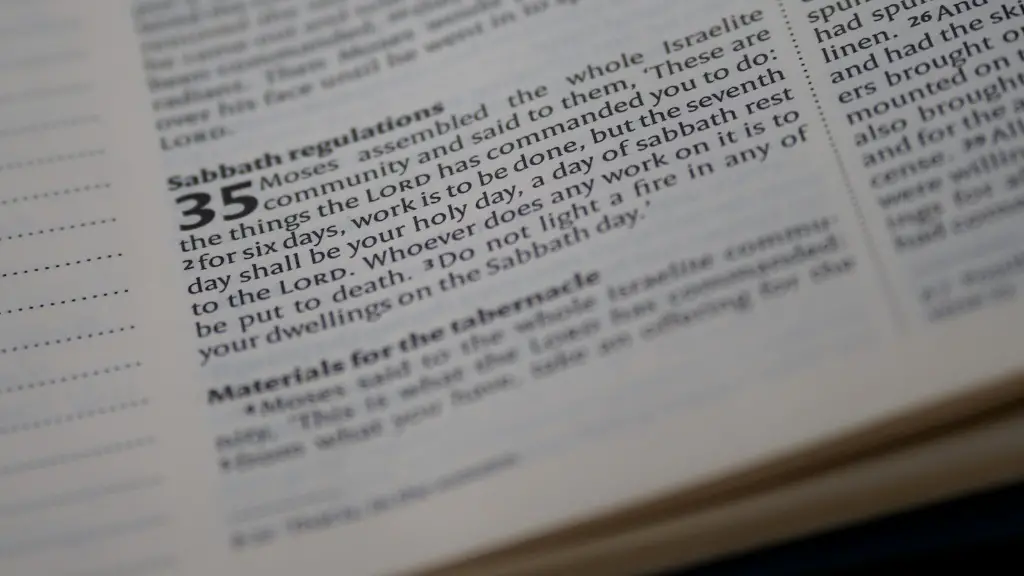Overview
How many versions of the Bible are there in English? The answer depends on who you ask and which sources you consult. In general, estimates range from around 10 up to around 200 translations and versions. The King James Version of the Bible, for example, is one of the most recognized Bible versions, with thousands of editions and hundreds of translations.
The King James Version of the Bible was published in 1611, and while it is one of the oldest and most famous English Bible translations, there are many other English bible translations today. The English language has changed considerably since the 1600s, and as a result, modern English speakers may find the language of the King James Version of the Bible to be difficult to understand.
In addition to the King James Version of the Bible, there are other historically significant English translations, such as the Douay-Rheims Bible, the American Standard Version of the Bible (ASV) and the New English Bible (NEB). These translations, of course, make up a small fraction of the many English translations and versions of the Bible that now exist.
Many of the modern English translation of the Bible are to some degree derived from earlier versions. For instance, the most popular modern translation of the Bible, the New International Version (NIV), is a revision of the ASV published in 1901. Revisions of the King James Version of the Bible include the Revised Standard Version (RSV), the New King James Version (NKJV) and the New Revised Standard Version (NRSV).
Modern Translations of the Bible
The NIV, RSV, NKJV, and NRSV are all revisions of the King James Version and other earlier translations of the Bible. Today, they are some of the most popular English translations of the Bible. But there are numerous other translations of the Bible in English. Translations that are closely related or derived from the King James Version are often called ‘versions’, while translations that are completely new works in the English language are called ‘translations’.
In recent years, a number of Bible translators have sought to create a more accessible and up-to-date version of the Bible for modern readers. The trend has been toward more dynamic translations, meaning that words and phrases are translated more literally, with less attention to archaic and obsolete words and forms. Some of the more modern translations of the Bible include the English Standard Version (ESV), the New Living Translation (NLT) and the Common English Bible (CEB).
In addition to these more mainstream English translations of the Bible, there are many other translations in existence, some of which are produced by a single translator or a small group of translators. These smaller projects can result in a far more accessible translation of the Bible for modern readers.
The Role of the Bible Translator
Translating the Bible into different languages is a complex task that requires both linguistic and theological knowledge. The task of the Bible translator is to accurately convey the meaning of the original text in a form that is clear, meaningful and faithful to the original language and message. The nuances of expression and implications of the text have to be understood, and the translator must be able to differentiate between cultural and theological ideas that do not carry over into the target language.
Translators must be aware of the cultural and religious context of the original text, which includes the author’s intended audience, original language, and grammar. In addition, they must be familiar with the receiving culture and the context of its own language.
A particular challenge that Bible translators often face is how to accurately combine word-for-word literal translations with wider contextual understanding. With each translation attempt, important questions must be asked such as, ‘Was a given expression typical of the language at the time the biblical book was composed?’, ‘Does such a rendering accurately represent the intended message of the author?’ and ‘Will the new translation be both understandable and meaningful for the target audience?’
Comparing Bible Translations
Different versions of the Bible have different strengths and weaknesses. Consequently, comparing different translations is an important way to understand the range of possible meanings that the original Hebrew, Aramaic, and Greek can have for English readers. In some cases, multiple translations can convey the same idea, even if the wording is slightly different. For example, Psalm 23:5 has been translated as “You prepare a table before me in the presence of my enemies,” but it can also be accurately rendered as, “You set a banquet before me as my foes watch.”
When comparing different translations of the Bible, the different styles should be taken into consideration. Some translations favor literal word-for-word renderings, while others prioritize readability and comprehension. Additionally, some translations are better suited for personal or private reading, while others are better suited for public or corporate reading. This is an important consideration when choosing a Bible version to read or use in a group setting.
Takeaways
When it comes to how many versions of the Bible are there in English, the answer is both straightforward — there are many — and complex. Many translations are revisions and versions of earlier works, and there is no one-size-fits-all answer to which is the best translation. Instead, the decision comes down to the reader, who should consider the purpose of their reading, the level of readability, and the target audience.
Bible Study Resources
Learning to understand and study the Bible can be overwhelming. Fortunately, there are numerous resources available to help. Bible studies, commentaries, devotionals and other related books can provide insight and context to the Bible. Additionally, there are websites, podcasts and other digital tools to help new readers become more familiar with the Bible.
Bible apps are also useful tools for anyone looking to gain a better understanding of the Bible. Not only do they provide access to a variety of translations, they also offer study tools like audio and video commentaries, devotionals and other reading plans. Apps also make it easier to bookmark verses and highlight important passages, making it easier to dive deeply into the Bible’s meaning and history.
Exploring the Bible in Different Languages
In addition to the many Bible translations in the English language, the Bible has also been translated into many other languages. While most languages have multiple translations, translations for some languages, such as Serbian, Yoruba, and Swahili, have only one. Additionally, some translations may be tailored to local dialects and cultures, providing an even more nuanced and personal interpretation of the Bible.
Learning about different translations of the Bible is a great way to gain a deeper understanding of the Bible’s history and message. With a variety of translations available, readers can explore the Bible in different languages and be exposed to different interpretations and meanings.
Conclusion
For English readers, there are many versions of the Bible. Estimate vary, but estimates range from around 10 up to around 200 translations and versions. Some of the more popular versions include the King James Version, the NIV, the RSV, the NLT, and the ESV. Each version has its own strengths and weaknesses, so readers should consider their purpose and audience when selecting a translation. Additionally, the Bible is available in many other languages and dialects, providing readers with even more opportunities to explore the Bible and its message.




